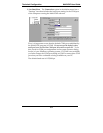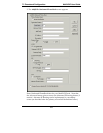
MultiVOIP User Guide T1 PhoneBook Configuration
171
T1 Versus E1 Telephony Environments
We present separate chapters for the MVP2410 MultiVOIP (this
chapter) and the MVP3010 MultiVOIP (Chapter 7) because the
respective telephony environments in which they operate have
different standards and conventions. The MVP2410 is designed to
operate under North American or T1 standards; the MVP3010 is
designed to operate under European or E1 standards. The
configuration of the phonebook is the same in either case. However,
differences in the telephony environment give rise to different
examples in each case. Series II analog MultiVOIP units (MVP130,
MVP130FXS, MVP210, MVP410, and MVP810) can be operated in
either the T1 or E1 environments. The examples in this chapter show
these analog voip units being used in the same system as the MVP2410
digital MultiVOIP.
Configuring T1 (NAM) Telephony
MultiVOIP Phonebooks
When a VoIP serves a PBX system, it’s important that the operation of
the VoIP be transparent to the telephone end user. That is, the VoIP
should not entail the dialing of extra digits to reach users elsewhere on
the network that the VoIP serves. On the contrary, VOIP service more
commonly reduces dialed digits by allowing users (served by PBXs in
facilities in distant cities) to dial their co-workers with 3-, 4-, or 5-digit
extensions as if they were in the same facility.
Furthermore, the setup of the VoIP generally should allow users to
make calls on a non-toll basis to any numbers accessible without toll by
users at all other locations on the VoIP system. Consider, for example,
a company with VOIP-equipped offices in New York, Miami, and Los
Angeles, each served by its own PBX. When the VOIP phone books are
set correctly, personnel in the Miami office should be able to make calls
without toll not only to the company’s offices in New York and Los
Angeles, but also to any number that’s local in those two cities.
To achieve transparency of the VoIP telephony system and to give full
access to all types of non-toll calls made possible by the VOIP system,
the VoIP administrator must properly configure the “Outbound” and
“Inbound” phone-books of each VoIP in the system.
The “Outbound” phonebook for a particular VoIP unit describes the
dialing sequences required for a call to originate locally (typically in a
PBX in a particular facility) and reach any of its possible destinations at


















